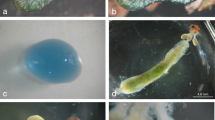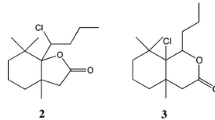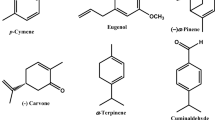Abstract
We have tested the insect antifeedant and toxic activity of 43 norditerpenoid alkaloids on Spodoptera littoralis and Leptinotarsa decemlineata including eserine (physostigmine), anabasine, and atropine. Antifeedant effects of the test compounds were structure- and species-dependent. The most active antifeedants to L. decemlineata were 1,14-diacetylcardiopetaline (9) and 18-hydroxy-14-O-methylgadesine (33), followed by 8-O-methylconsolarine (12), 14-O-acetyldelectinine (27), karakoline (7), cardiopetaline (8), 18-O-demethylpubescenine (13), 14-O-acetyldeltatsine (18), takaosamine (21), ajadine (24), and 8-O-methylcolumbianine (6) (EC50 <1 μg/cm2). This insect showed a moderate response to atropine. S. littoralis had the strongest antifeedant response to 24, 18, 14-O-acetyldelcosine (19), and delphatine (29) (EC50 <3 μg/cm2). None of the model substances affected the feeding behavior of this insect. The most toxic compound to L. decemlineata was aconitine (1), followed by cardiopetalidine (10) (% mortality >60), 14-deacetylpubescenine (14), 18-O-benzoyl-18-O-demethyl-14-O-deacetylpubescenine (17), 14-O- acetyldelcosine (19), 14-deacetylajadine (25) and methyllycaconitine (30) (% mortality >45). Orally injected S. littoralis larvae were negatively affected by 1, cardiopetaline (8), 10, 1,14-O-acetylcardiopetalidina (11), 12, 14, 1,18-O-diacetyl-19-oxo-gigactonine (41), olivimine (43), and eserine in varying degrees. Their antifeedant or insecticidal potencies did not parallel their reported nAChR binding activity, but did correlate with the agonist/antagonist insecticidal/antifeedant model proposed for nicotininc insecticides. A few compounds [14, tuguaconitine (38), 14-demethyldelboxine (40), 19, dehydrodelsoline (36), 18-O-demethylpubescenine (13), 41, 9, and delcosine (23)] had selective cytotoxic effects to ward insect-derived Sf9 cells. None were cytotoxic to mammalian CHO cells and none increased Trypanosoma cruzi mortality. The selective cytotoxic effects of some structures indicate that they can act on biological targets other than neuroreceptors.
Similar content being viewed by others
REFERENCES
ABBOTT, W. S. 1925. A method of computing the effectiveness of an insecticide. J. Econ. Entomol. 18:265–267.
ALBA, A., GRANDEZ, M., MEDINAVEITIA, A., DE LA FUENTE, G., and GAVIN, J. A. 2004a. Seven new norditerpenoid alkaloids from Spanish Consolida orientalis. Hel. Chim. Acta. 87.
ALBA, A., GRANDEZ, M., MEDINAVEITIA, A., DE LA FUENTE, G., and GAVIN, J. A. 2004b. Three new norditerpenoid alkaloids from Consolida orientalis. Chem. Pharm. Bull. 52.
ATTA-UR-RAHMAN and CHOUDARY, M. I. 1995. Diterpenoid and steroidal alkaloids. Nat. Prod. pep.12:361–379.
BLOOMQUIST, J. R. 2001. GABA and glutamate receptors as biochemical sites for insecticide action, pp. 17–41, inI. Ishaaya (ed.). Biochemical Sites of Insecticide Action and Resistance. Springer-Verlag, Berlin.
COHEN, R. W., MAHONEY, D. A., and CAN, H. D. 2002. Possible regulation of feeding behavior in cockroach nymphs by the neurotransmitter octopamine. J. Insect Behav.15:37–50.
DE LA FUENTE, G. and REINA, M. 1990. Some phytochemical studies of Aconitum, Delphinium and Consolidagenera. Collect. Bot .19:129–140.
DE LA FUENTE, G. and RUIZ-MESIA, L. 1994. Norditerpenoid alkaloids from Aconitum vulpariasubsp. Neapolitanum. Phytochemistry 37:271–274.
DOBELIS, P., MADL, J. E., PFISTER, J. A., MANNERS, G. D., and WALROND, J. P. 1999. Effects of Delphiniumalkaloids on neuromuscular transmission. J. Pharm. Exp. Ther.291:538–546.
FRIESE, J., GLEITZ, J., GUTSTER, U. T., HENBACH, J. F., MATTHIESEN, T., WILFFERT, B., and SELVE, N. 1997. Aconitumsp alkaloids: The modulation of voltage-dependent Na+ channels, toxicity and antinoniceptive properties. Eur. J. Pharmacol.337:165–174.
GONZÁLEZ, A. G., DE LA FUENTE, G., MUNGUIA, O., and HENRICK, K. 1981. Structure of 18-hydroxy-14-O-methylgadesine. A new diterpene alkaloid from Consolida orientalis. Tetrahedron Lett .22:4843–4844.
GONZÁLEZ, A. G., DE LA FUENTE, G., REINA, M., and DÍAZ, R. 1986. The structures of four new diterpenoids alkaloids. Heterocycles 24:1513–1516.
GONZÁLEZ-COLOMA, A., GUADAÑO, A., DE INÉS, C., MARTINEZ-DÍAZ, R., and CoRTES, D. 2002a.Selective action of acetogenin mitochondrial Complex I inhibitors. Z. Naturforsch C 57:1028–1034.
GONZÁLEZ-COLOMA, A., GUADAÑO, A., GUTIÉRREZ, C., CABRERA, R., DE LA PE ÑA, E., DE LA FUENTE, G., and REINA,M. 1998. Antifeedant Delphinium diterpene alkaloids. structure-activity relationships. J. Agric. Food Chem.46:286–290.
GONZÁLEZ-COLOMA, A., VALENCIA, F., MARTÍN, N., HOFFMANN, J. J., HUTTER, L., MARCO, J. A., and REINA, M. 2002b. Silphinene sesquiterpenes as model insect antifeedants. J. Chem. Ecol.28:117–129.
GRANDEZ, M., MEDINAVEITIA, A., GAVIN, J. A., ALVA, A., and DE LA FUENTE, G. 2002. Alkaloids from Consolida oliveriana. J. Nat. Prod.65:513–516.
HARDICK, D. J., BLAGBROUGH, I. S., COOPER, G., POTTER, B. V., CRITCHLEY, T., and WONNACOTT, S. 1996. Nudicauline and elatine as potent norditerpenoid ligands at rat neuronal alpha-bungarotoxin binding sites: Importance of the (methylsuccinimido) benzoyl moiety for neuronal nicotinic acetylcholine receptor binding. J. Med. Chem.39:4860–4866.
HEINZ, C. A., ZANGERL, A. R., and BERENBAUM, M. 1996. Effects of natural and synthetic neuroactive substances on the growth and feeding of cabbage looper Trichoplusia ni. Entomol. Exp. Appl.80:443–451.
HORTON, R. D. and REDAK, R. A. 1993. Further comments on analysis of covariance in insect dietary studies. Entomol. Exp. Appl.69:263–275.
JENNINGS, K. R., BROWN, D. G., and WRIGHT, D. P. J. 1986. Methyllycaconitine, a naturally occuring insecticide with a high affinity for the insect cholinergic receptor. Experientia 42:611–613.
KNUEPFER, M. M. and GAN, Q. 1999. Role of cholinergic receptors and cholinesterase activity in hemodynamic responses to cocaine in conscious rats. Am. J. Physiol.276:R103–R112.
KUKEL, C. F. and JENNINGS, K. R. 1994. Delphiniumalkaloids as inhibitors of a-bungarotoxin binding to rat and insect neural membranes. Can. J. Physiol. Pharmacol.72:104–107.
LIU, M.-Y., LATLI, B., and CASIDA, J. E. 1995. Imidacloprid binding site in Muscanicotinic acetylcholine receptor: Interactions with physostigmine and a variety of nicotinic agonists with chloropyridyl and chlorothiazolyl substituents. Pestic. Biochem. Physiol. 52:170–181.
MOSSMAN, T. 1983. Rapid colorimetric assay for cellular growth and survival: application to proliferation and cytotoxicity assays. J. Immunol. Methods 65:55–63.
MULLIN, C. A., GONZÁLEZ-COLOMA, A., GUTIÉRREZ, C., REINA, M., EICHENSEER, H., HOLLISTER, B., and CHYB, S. 1997. Antifeedant effects of some novel terpenoids on Chrysomelidae beetles: Comparisons with alkaloids on an alkaloid-adapted and a non-adapted species. J. Chem. Ecol. 23:1851–1866.
NAUEN, R., EBBINGHAUS, U., and TIETJEN, K. 1999. Ligands of the nicotinic acetylcholine receptor as insecticides. Pestic. Sci. 55:566–614.
PANTER, K. E., MANNERS, G. D., STEGELMEIER, B. L., GARDNER, D. R., RALPHS, M. H., PFISTER, J. A., and JAMES, L. F. 2002. Larkspur poisoning: Toxicology and alkaloid structure-activity relationships. Biochem. Syst. Ecol. 30:113–128.
RALPHS, M. H., GARDNER, D. R., TURNER, D. L., PFISTER, J. A., and THACKER, E. 2002. Predicting toxicity of tall larkspur (Delphinium barbeyi): Measurement of the variation alkaloid concentration among plants and among years. J. Chem. Ecol. 28:2327–2341.
RALPHS, M. M. and GARDNER, D. R. 2003. Distribution of norditerpene alkaloids in tall larkspur plant parts through the growing season. J. Chem. Ecol.29:2013–2021.
RAUBENHEIMER, D. and SIMPSON, S. J. 1992. Analysis of covariance: An alternative to nutritional indices. Entomol. Exp. Appl. 62:221–231.
REINA, M., GONZÁLEZ-COLOMA, A., GUTIÉRREZ, C., CABRERA, R., RODRÍGUEZ, M. L., FAJARDO, V., and VILLARROEL, L. 2001. Defensive chemistry of Senecio miser Hook. J. Nat. Prod .64:6–11.
REINA, M., NOLD, M., SANTANA, O., ORIHUELA, J. C., and GONZÁLEZ-COLOMA, A. 2002. C-5 substituted antifeedant silphinene sesquiterpenes. J. Nat. Prod.65:448–453.
SANES, J. R., PRESCOTT, D. J., and HILDEBRAND, J. G. 1977. Cholinergic neurochemical development of normal and deafferented antennal lobes during metamorphosis of the koth Manduca sexta. Brain. Res .119:389–402.
SEITZ, U. and AMERI, A. 1998. Different effects of [3H] noradrenaline uptake of the aconitum alkaloids aconitine, 3-acetylaconitine, lappaconitine, and N-desacetyllappaconitine in rat hippocampus. Biochem. Pharmacol.55:883–888.
STEGELMEIER, B. L., PANTER, K. E., PFISTER, J. A., JAMES, L. F., MANNERS, G. D., GARDNER, D. R., RALPHS, M. H., and OLSEN, J. D. 1998. Experimental modification of larkspur (Delphiniumspp) toxicity, pp. 205–210, inT. Gardland and G. Barr (eds.). Toxic Plants and Other Natural Toxicants. CAB International, New York.
SULTANA, I., IKEDA, I., and OZOE, Y. 2002. Structure-activity relationships of benzylidene anabasines in nicotinic acetylcholine receptors of cockroach nerve cords. Bioorg. Med. Chem.10:2963–2971.
ULUBELEN, A., MERICLI, A., KILINCER, N., FERIZLI, A. G., EMECKI, M., and PELLETIER, W. 2001. Insect repellent activity of diterpenoid alkaloids. Phytother. Res.15:170–171.
WINK, M., SCHMELLER, T., and LATZ-BRÜNING, B. 1998. Modes of action of allelochemical alkaloids: Interaction with neuroreceptors, DNA and other molecular targets. J. Chem. Ecol.24:1881–1937.
Author information
Authors and Affiliations
Corresponding author
Rights and permissions
About this article
Cite this article
González-Coloma, A., Reina, M., Medinaveitia, A. et al. Structural Diversity and Defensive Properties of Norditerpenoid Alkaloids. J Chem Ecol 30, 1393–1408 (2004). https://doi.org/10.1023/B:JOEC.0000037747.74665.0a
Issue Date:
DOI: https://doi.org/10.1023/B:JOEC.0000037747.74665.0a




